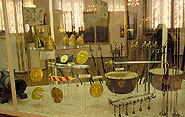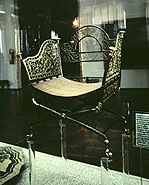

The story of the Turkish wars continues without break into the "Hall of Maria Theresa," named for the Empress who dominated Austrian history in the middle of the eighteenth century. She is shown here in the monument that dominates the square in Vienna named for her, located between the Art History Museum and the Museum of Natural History. She holds a copy of the document affirming her right to the Habsburg dominions. Allegoric figures of Power, Wisdom, Justice and Mercy surround her along with mounted figures of her most famous generals. The statue, designed by Kaspar Zumbusch, was erected in 1888. Although initially the right of a woman to succeed to the imperial throne was contested by neighboring countries (notably the rising power in Northern Europe, Prussia), during much of her reign she presided over military successes. One of her sixteen children, Marie Antoinette, as Queen of France, would lose her head on the guillotine during the French Revolution. This was the age of "Enlightened Despotism." Maria Theresa's son and successor, Emperor Joseph II, was known for various internal reforms, although the social and ethnic tensions in the sprawling multi-national empire posed a serious threat for its future. During his reign, the Austrian armies continued to be successful against the Turks, and Austria benefitted from the carving up of Poland in collaboration with Russia and Prussia.


These photos depict some of the displays in the Hall of Empress Maria Theresa, including a folding camp chair made in the famous Russian iron-works at Tula south of Moscow and bearing the monogram of Russian Empress Elizabeth. Russia was frequently allied with the Habsburgs in the wars against Prussia and against the Turks in the eighteenth century.